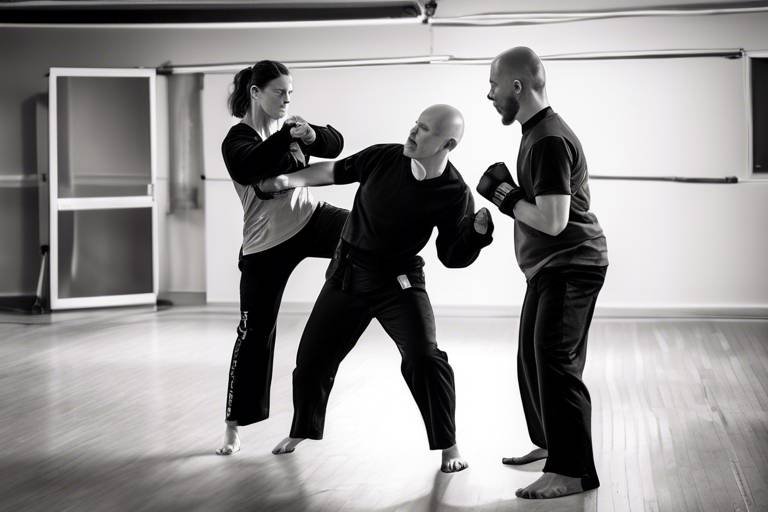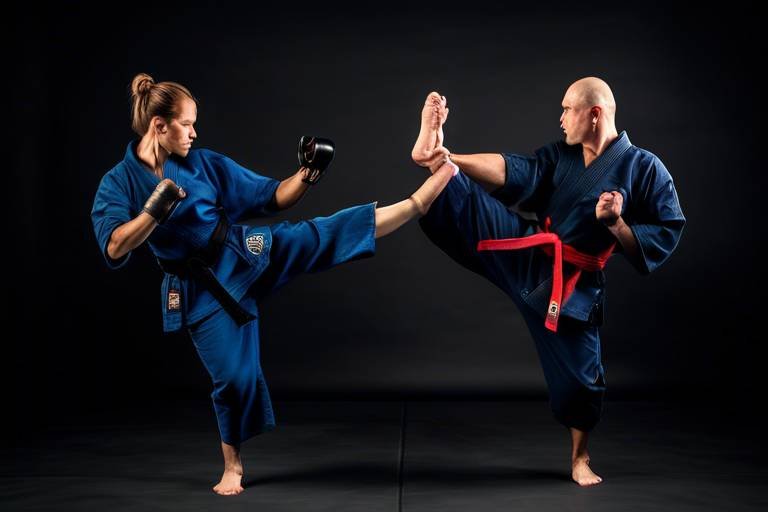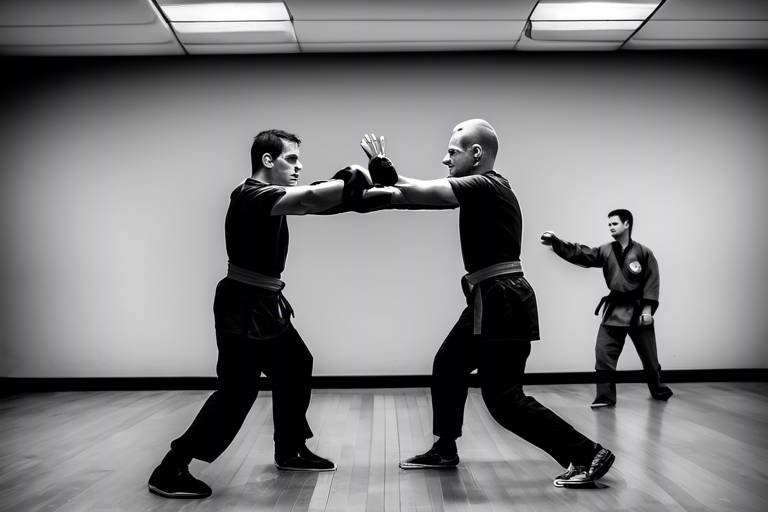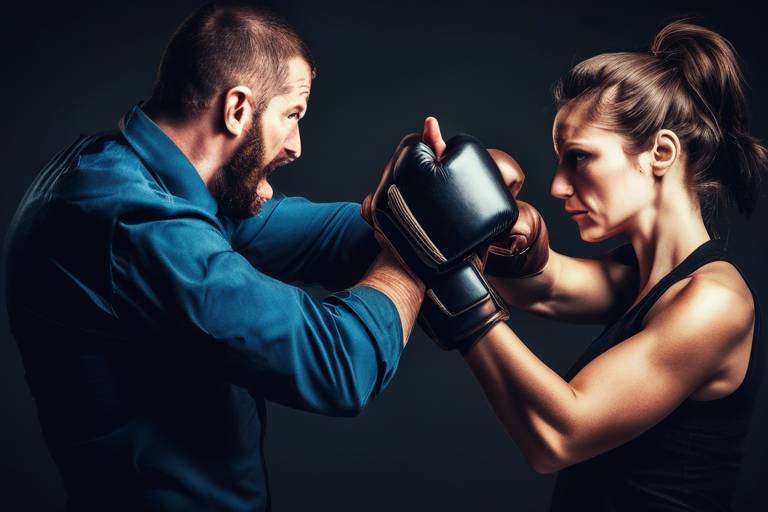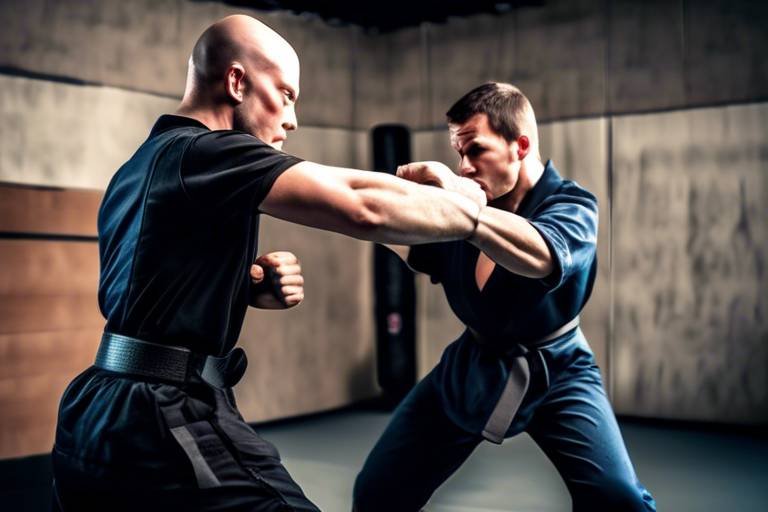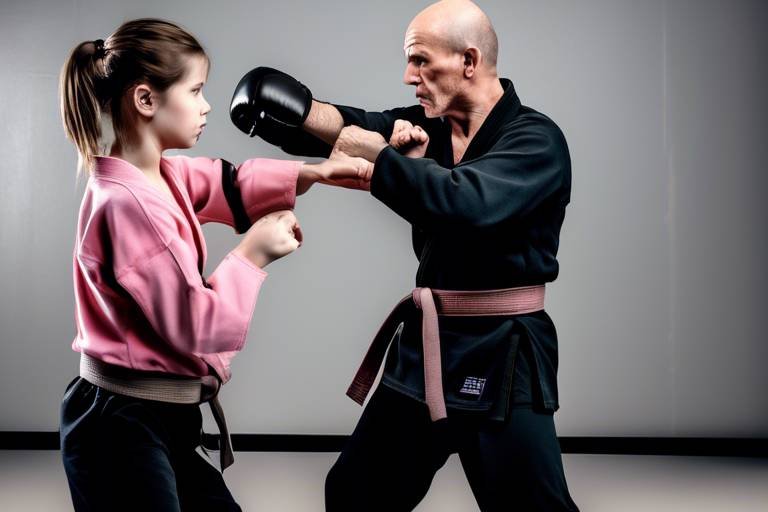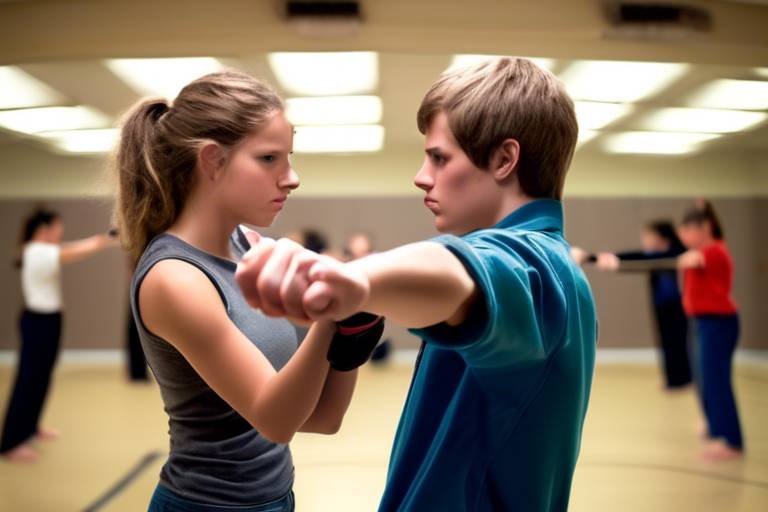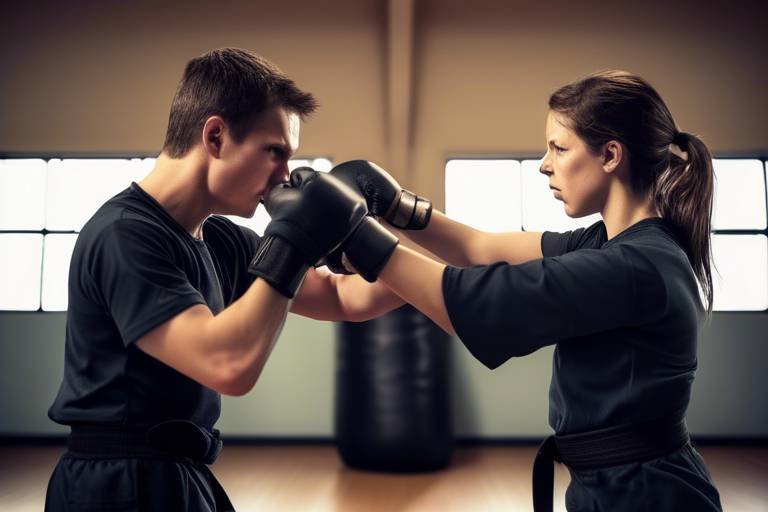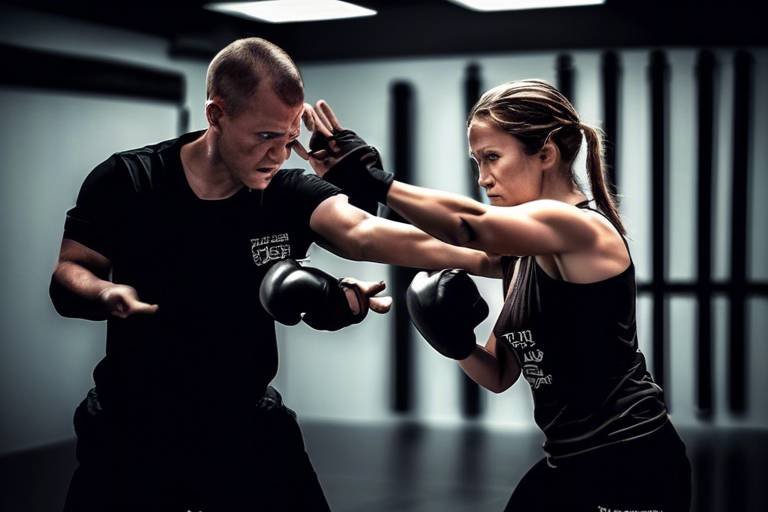Improvising with Available Resources in Self-Defense Training
In today's unpredictable world, the ability to defend oneself is more important than ever. However, what if you find yourself in a situation where traditional self-defense tools are not available? This is where the concept of improvisation comes into play. Improvising with available resources means using whatever is at hand to protect yourself, and it can be a game changer in critical situations. Whether you're at home, in a park, or even at work, understanding how to utilize your environment and everyday items can empower you to respond effectively to threats. This article explores the art of improvisation in self-defense training, showcasing how to turn ordinary objects into extraordinary tools for personal safety.
Resourcefulness is not just a skill; it's a mindset that can significantly enhance your self-defense capabilities. When faced with a potential threat, being able to think on your feet and adapt to your surroundings can make all the difference. Imagine walking down the street and suddenly encountering an aggressive individual. Instead of panicking, your training kicks in, and you quickly assess your environment. Are there items nearby that can be used for self-defense? Is there a way to escape? This kind of quick thinking is crucial for personal safety and can be developed through practice.
Believe it or not, many items you interact with daily can be transformed into effective self-defense tools. The key is understanding how to use these items creatively. For instance, a simple pen can become a powerful striking tool, while a set of keys can serve as a defensive weapon. Knowing how to wield these items effectively can provide a surprising advantage in an emergency situation. Let's dive deeper into some of these common household items that can serve as self-defense tools.
Household items are often overlooked when it comes to self-defense, but they can be incredibly effective. Consider the following:
- Keys: These can be used to strike an attacker or create a distraction. The jagged edges can inflict pain, and when held between your fingers, they can act as a makeshift weapon.
- Pens: A sturdy pen can be used to jab at sensitive areas, such as the eyes or throat, making it a great tool for self-defense.
- Kitchen Utensils: Items like spatulas or even a heavy frying pan can be used to defend yourself against an attacker.
Your keys can be one of the most effective self-defense tools you have on hand. When held properly, they can deliver a powerful strike. The technique involves holding the keys between your fingers, allowing the jagged edges to act as a weapon. This method can create a surprising impact, potentially giving you the chance to escape. Remember, the goal is not to engage but to create an opportunity to get away safely.
Kitchen utensils may seem mundane, but they can serve as excellent self-defense tools. A common kitchen knife can be wielded to fend off an attacker, while a spatula can be used to deflect blows. It's essential to practice using these items safely, ensuring that you can react quickly if the need arises. Knowing how to turn your kitchen into a safe haven can provide peace of mind in an emergency.
Your clothing can also play a significant role in self-defense. Items like belts, scarves, or jackets can be used creatively to defend yourself. A belt can be used to restrain an attacker or even as a striking tool. Scarves can be employed to distract or confuse an assailant, while jackets can be thrown to obstruct vision or create distance. The versatility of clothing in self-defense situations is often underestimated, but with a little creativity, it can be a valuable asset.
Being aware of your surroundings is vital for effective self-defense. It's not just about knowing how to fight; it's also about understanding how to utilize your environment to your advantage. This awareness can create opportunities for escape or defense, significantly increasing your chances of staying safe.
Knowing the layout of your surroundings can be a lifesaver. As you walk through different environments, take a moment to identify potential escape routes. Are there exits nearby? Is there a crowd you can blend into? This knowledge can help you react quickly in dangerous situations, allowing you to escape rather than confront a threat directly.
Obstacles in your environment can be leveraged to create barriers between you and an attacker. For instance, if you're in a park, you might use benches or trees to shield yourself or create distance. Learning how to navigate these obstacles can enhance your defensive strategies significantly. The more familiar you are with your environment, the better equipped you'll be to handle unexpected situations.
Q: Can any item be used for self-defense?
A: While many items can be improvised for self-defense, it's essential to assess the situation and ensure that you can use the item safely and effectively.
Q: Is it legal to use everyday items for self-defense?
A: Laws regarding self-defense vary by location, so it's crucial to understand the regulations in your area concerning the use of force.
Q: How can I practice using everyday items for self-defense?
A: Consider enrolling in self-defense classes that focus on improvisation, or practice at home with a friend to simulate various scenarios.

The Importance of Resourcefulness
Resourcefulness is a crucial skill in self-defense training that goes beyond just knowing how to throw a punch or execute a perfect kick. It’s about being able to adapt to any situation using what you have at your disposal. Imagine walking down the street and suddenly finding yourself in a threatening situation. What do you do? Instead of panicking, a resourceful person can quickly assess their surroundings and utilize everyday items or their environment to protect themselves. This mindset can be the difference between safety and vulnerability.
Think about it: the world is filled with objects that can be transformed into effective self-defense tools. From your car keys to a nearby trash can lid, almost anything can become a weapon in the right hands. This flexibility not only empowers individuals but also instills a sense of confidence. When you know you can defend yourself using whatever is around, you feel less anxious about potential threats. It’s like being a magician, turning ordinary objects into extraordinary tools for survival.
Moreover, developing resourcefulness in self-defense training encourages a proactive approach to personal safety. Instead of waiting for a dangerous situation to unfold, individuals learn to anticipate and prepare for potential threats. This preparation can involve practicing with various items found in your environment, which not only enhances your skills but also boosts your overall awareness. For instance, consider the following common scenarios:
| Scenario | Resourceful Response |
|---|---|
| Walking alone at night | Using your phone as a flashlight and a distraction tool |
| Being approached by a stranger | Utilizing your keys for defense while maintaining a confident posture |
| Finding yourself in a crowded area | Identifying potential escape routes and using obstacles to shield yourself |
In each of these scenarios, the ability to think on your feet and utilize your surroundings can significantly enhance your chances of staying safe. It’s not just about having physical strength; it’s about being mentally agile and ready to act. This is why incorporating resourcefulness into self-defense training is essential. It prepares you to face real-life situations with a practical mindset, ensuring that you can respond effectively, no matter where you are.
Ultimately, the importance of resourcefulness in self-defense training cannot be overstated. It equips individuals with the necessary tools to navigate potentially dangerous situations, turning the mundane into a sanctuary of safety. By fostering this skill, we not only enhance our physical capabilities but also build a resilient mindset that prioritizes personal safety and awareness.

Common Everyday Items as Weapons
When it comes to self-defense, the notion that you need specialized tools or extensive training is a myth. In fact, many common everyday items can be transformed into effective self-defense weapons. Imagine walking down the street, and suddenly you find yourself in a precarious situation. Wouldn't it be empowering to know that the items you carry every day could help you defend yourself? This is where the magic of resourcefulness kicks in! By understanding how to use these items creatively, you can significantly enhance your ability to protect yourself when it matters most.
Let’s take a closer look at some of these everyday items that can serve as surprising self-defense tools. You might be surprised to learn that things like your keys, pens, and even kitchen utensils can be wielded effectively in a pinch. Knowing how to use these items can provide you with a surprising advantage in emergencies, turning mundane objects into powerful allies.
Household items are often overlooked in self-defense discussions, yet they can be incredibly effective. For example, your keys can be more than just a means to unlock your front door. With the right technique, they can be used as an improvised weapon. Holding your keys between your fingers while making a fist can create a striking tool that can inflict damage on an attacker. It’s a simple yet effective way to defend yourself without needing to carry a weapon.
Similarly, kitchen utensils can serve as excellent self-defense tools. A knife is an obvious choice, but even a spatula or a rolling pin can be utilized creatively. Imagine you’re in your kitchen and someone intrudes—grabbing a spatula might seem trivial, but it can be used to block strikes or create distance between you and the attacker. Knowing how to wield these items can turn your home into a fortress, providing you with the means to protect yourself effectively.
Let’s delve a bit deeper into using keys and keychains. When you hold your keys, make sure to grip them tightly, allowing them to protrude from your fist. This way, you can use them to jab at an attacker’s face or eyes, which can be a critical distraction. The element of surprise is on your side—most attackers wouldn’t expect you to fight back with something as simple as your keys. Remember, it’s not about the item itself but how you use it!
In addition to knives, think about other kitchen utensils that can come in handy. A pot lid can be used as a shield, while a wooden spoon can serve as an effective tool to strike. The key is to stay calm and think creatively. In a moment of panic, the ability to improvise with what’s around you can be a game-changer. So, the next time you're in your kitchen, consider how you might use various utensils to your advantage.
Don’t forget about your clothing! Items like belts, scarves, and even jackets can be repurposed for self-defense. A belt can be used to whip at an attacker or to create distance, while a scarf can be utilized to distract or entangle. Your clothing can provide both protection and distraction, enhancing your defensive capabilities in critical moments.
In conclusion, the key to effective self-defense lies not just in traditional weapons but in the ability to think on your feet and utilize what you have around you. Everyday items can be powerful tools when used creatively and with intention. So, the next time you step out, remember that you are never truly unarmed!
- Can I really use household items for self-defense? Yes! Many common household items can be effectively used in self-defense situations.
- What are the best items to carry for self-defense? Keys, pens, and small kitchen utensils are great options to have on hand.
- How can I practice using these items? You can practice techniques at home or take self-defense classes that focus on improvisation.

Household Items
When we think about self-defense, the first things that come to mind are often martial arts techniques or specialized tools. However, the truth is that many can be transformed into effective self-defense tools, making it crucial to recognize their potential. Imagine being in a situation where you feel threatened, and instead of panicking, you reach for something as simple as a pen or a kitchen utensil. These items, which we often overlook, can provide a surprising advantage if used correctly.
Take, for example, your keys. While they may seem innocuous, they can be wielded as an improvised weapon. By holding the keys between your fingers, you create a makeshift striking tool that can deliver a sharp jab to an assailant. This technique not only maximizes the impact of your strike but also allows you to maintain a grip on your keys, making them readily accessible. It’s a perfect example of how resourcefulness can turn an everyday object into a means of protection.
Another common household item that can serve as a self-defense tool is the kitchen knife. While it’s primarily used for cooking, in a self-defense scenario, it can become a powerful ally. If you find yourself in a dangerous situation, knowing how to handle a knife safely and effectively can give you the upper hand. However, it’s essential to remember that using a knife comes with significant responsibility and should only be done in life-threatening situations.
Moreover, consider other kitchen utensils like spatulas or even a sturdy cutting board. These items can be used to block strikes or create distance between you and an attacker. The key is to stay calm and think creatively about how to use what’s around you. For instance, a spatula can be used to deflect an incoming blow, while a cutting board can serve as a shield. The adaptability of these items can make all the difference in a critical moment.
In addition to these tools, it’s also worth noting that items like scissors and heavy books can be effective in self-defense situations. Scissors, when wielded properly, can serve as a stabbing tool, while a heavy book can be thrown to distract or deter an attacker. The possibilities are endless, and the more familiar you become with these items, the better prepared you’ll be in an emergency.
Ultimately, the goal is to cultivate a mindset of resourcefulness and creativity. When you train yourself to think outside the box, you empower yourself to use whatever is at your disposal to defend against threats. So, the next time you’re in your home, take a moment to look around and consider how ordinary household items can be transformed into effective self-defense tools. It’s all about being prepared and knowing that safety can often be found in the most unexpected places.

Keys and Keychains
When it comes to self-defense, many people overlook the potential of everyday items, and keys are no exception. These small, seemingly innocuous objects can be transformed into effective self-defense tools with the right techniques. Imagine walking down a dimly lit street and suddenly feeling threatened; your keys, which you typically use to unlock your front door, can become your first line of defense. By holding your keys between your fingers, you can create a makeshift weapon that can deliver a sharp jab to an assailant.
But it’s not just about the act of striking. The psychological impact of using keys as a weapon can be significant. The surprise element can catch an attacker off guard, giving you the precious seconds needed to escape. In a world where we often feel vulnerable, knowing how to utilize your keys can be empowering. It's about turning the mundane into the extraordinary. So, how do you maximize the effectiveness of your keys in a self-defense scenario?
Here are some practical tips:
- Grip: Hold your keys tightly in your fist, with the key edges protruding between your fingers. This positioning allows you to strike effectively while minimizing the risk of injury to yourself.
- Aim for Sensitive Areas: Target vulnerable spots on an attacker, such as the eyes, throat, or groin. A well-placed jab can create an opportunity for you to escape.
- Practice: Just like any skill, practice is essential. Familiarize yourself with the motion of striking with your keys to build confidence in your ability to defend yourself.
Additionally, keychains can add another layer of utility to your self-defense strategy. Many keychains come equipped with features like small flashlights or even personal alarms, which can be used to draw attention in a dangerous situation. Some are designed specifically for self-defense, with pointed edges that can be used to strike. The key to effective self-defense is not just having the right tools but knowing how to use them creatively and effectively.
In conclusion, your keys and keychains are not just for unlocking doors; they can also be your unexpected allies in moments of danger. By understanding how to wield them properly, you can turn an everyday object into a powerful self-defense tool, enhancing your personal safety and confidence in uncertain situations.
Q: Can using keys for self-defense be illegal?
A: The legality of using keys for self-defense can vary by location. It's important to familiarize yourself with local laws regarding self-defense weapons.
Q: What if I don't have keys on me?
A: Always be aware of your surroundings. Look for other everyday items that can be used for self-defense, such as pens, umbrellas, or even your phone.
Q: Is it safe to practice self-defense techniques?
A: Yes, practicing self-defense techniques is generally safe when done in a controlled environment. Consider enrolling in a self-defense class to learn proper techniques and safety measures.

Kitchen Utensils
When it comes to self-defense, the kitchen is often an overlooked treasure trove of potential weapons. You might be surprised to learn that those everyday items you use for cooking can also serve as effective tools for protection. Imagine being in a situation where you need to defend yourself, and instead of panicking, you reach for a kitchen utensil. This is where the magic of improvisation kicks in!
Kitchen utensils like knives, spatulas, and even cutting boards can be transformed into self-defense tools with the right mindset and techniques. For instance, a chef's knife is not just for slicing vegetables; it can also be wielded to create distance between you and an attacker. The key is to understand how to use these items effectively and safely.
Here are a few examples of how common kitchen utensils can be utilized:
- Knives: The most obvious choice, knives can be used to deter an attacker. When holding a knife, aim for the vulnerable areas of an assailant, such as the eyes or hands, while maintaining your own safety.
- Spatulas: While they may seem harmless, a spatula can be used to block strikes or push an assailant away. Plus, they are lightweight and easy to handle, making them a great option in a pinch.
- Cutting Boards: Believe it or not, a sturdy cutting board can be used as a shield. If an assailant approaches, holding a cutting board in front of you can create a barrier and give you a moment to escape.
It's essential to practice these techniques in a safe environment. Consider setting up a mock scenario where you can simulate using these utensils for defense. This not only boosts your confidence but also helps you internalize the movements. Remember, the goal is to create distance and escape, not necessarily to engage in a fight.
Additionally, think about the element of surprise. An attacker may not expect you to fight back with a kitchen utensil, which can give you a crucial advantage. The more resourceful you are, the better prepared you will be in a crisis. So, the next time you're in the kitchen, take a moment to assess your surroundings and think about how you could use what you have at hand to protect yourself.
1. Can I really use kitchen utensils for self-defense?
Absolutely! Many kitchen utensils can be effective for self-defense if used properly. The key is to know how to wield them safely and effectively.
2. Are there any risks involved in using household items for self-defense?
Yes, there are risks. It's crucial to practice in a safe environment to avoid accidental injury to yourself or others. Always prioritize your safety and the safety of those around you.
3. How can I practice using kitchen utensils for self-defense?
Consider enrolling in a self-defense class that incorporates everyday items or practice with a friend in a controlled environment. Role-playing different scenarios can help you feel more prepared.
4. What should I do if I don't have any kitchen utensils available?
You can still defend yourself using your body. Techniques such as striking vulnerable areas or using your surroundings can be just as effective. Always be aware of your environment!

Using Clothing as Defense Tools
When it comes to self-defense, many people overlook the potential of their clothing as an effective defense tool. Imagine walking down the street and suddenly finding yourself in a threatening situation. Instead of feeling helpless, you can use what you’re wearing to your advantage. Clothing items like belts, scarves, and jackets can be transformed into makeshift tools that enhance your defensive capabilities. For instance, a sturdy belt can serve as a whip-like weapon, allowing you to strike or distract an attacker. The key is to think creatively and act quickly.
Let’s take a closer look at some common clothing items that can be utilized in self-defense scenarios:
- Belts: A belt can be an excellent tool for self-defense. Not only can it be used to strike an assailant, but it can also be used to restrain or bind them if necessary. The weight and flexibility of a belt allow for various defensive maneuvers.
- Scarves: A scarf can be used in multiple ways. It can serve as a distraction, or you can use it to choke or bind an attacker. A long scarf can also be wrapped around your hand for added protection while striking.
- Jackets: Your jacket can be utilized to shield yourself from blows or even to throw over an attacker’s head, creating confusion and an opportunity to escape. The bulkiness of a jacket can also provide a barrier, making it harder for an assailant to grab you.
Additionally, wearing clothing made from tougher materials can enhance your self-defense strategy. Fabrics such as denim or leather not only provide durability but can also offer protection against cuts or scrapes. When choosing your outfit for the day, consider how each item can serve a dual purpose. This mindset of preparedness can make all the difference in a critical moment.
In conclusion, thinking outside the box when it comes to utilizing clothing for self-defense can empower individuals to feel more secure in their environments. By recognizing that your everyday attire can be a valuable asset, you can enhance your confidence and readiness to respond to unexpected situations. Remember, the best defense is being prepared, and that includes leveraging the items you already have at your disposal.
Q: Can I really use clothing as a weapon for self-defense?
A: Yes! Items like belts, scarves, and jackets can be creatively used to defend yourself. They can distract, restrain, or even strike an attacker when used effectively.
Q: What should I wear for better self-defense capabilities?
A: Opt for durable fabrics like denim or leather, as they offer protection and can be used in various defensive maneuvers. Additionally, consider clothing that allows for easy movement.
Q: Is it safe to rely on improvised tools for self-defense?
A: While improvised tools can be effective, it is essential to combine them with proper self-defense training. Being aware of your surroundings and having a plan can significantly increase your safety.

Environmental Awareness
When it comes to self-defense, being aware of your surroundings is not just a good habit; it’s a critical skill that can make the difference between safety and danger. Think of your environment as a chessboard where every piece can either help you or hinder you. By honing your environmental awareness, you can turn everyday situations into opportunities for escape or defense. So, how can you develop this skill effectively?
First and foremost, it’s essential to observe your surroundings actively. This means not just looking but actively analyzing what’s around you. Are there exits nearby? Are there people around who could help? Is there anything in your environment that you could use to your advantage? These questions should constantly run through your mind as you navigate through various spaces, be it a crowded street or a quiet park.
One of the most effective strategies in self-defense is identifying potential escape routes. Imagine you’re in a situation where you feel threatened; knowing where to run can be a lifesaver. Here are some tips to help you identify escape routes:
- Always know the layout of the place you’re in, whether it’s a mall, office, or even your own home.
- Look for exits that are not just doors but also windows or emergency exits.
- Consider the terrain; if you’re outside, know where the bushes, fences, or other structures are.
Additionally, understanding how to use obstacles in your environment can significantly enhance your defensive strategies. For example, if you find yourself in a tight spot, you can use furniture or other barriers to create distance between you and an attacker. This is similar to playing a game of hide-and-seek; the more obstacles you have between you and the ‘seeker,’ the better your chances of escaping unnoticed. Here are some common obstacles you can leverage:
- Furniture: Tables, chairs, and even couches can serve as barriers.
- Landscaping: Trees, bushes, and garden features can provide cover.
- Vehicles: Cars can be used for concealment and as a shield.
Finally, it’s crucial to practice these skills in real-life scenarios. Consider engaging in activities like parkour or martial arts training that emphasize environmental awareness. These practices can help you learn to navigate your surroundings fluidly, turning you into a more confident and capable individual when faced with a threat.
Q1: Why is environmental awareness important in self-defense?
A1: Environmental awareness helps you identify escape routes and potential tools for defense, making it easier to respond to threats effectively.
Q2: How can I improve my environmental awareness?
A2: You can improve your awareness by actively observing your surroundings, practicing situational awareness exercises, and engaging in self-defense training that incorporates environmental navigation.
Q3: What are some common obstacles I can use in self-defense?
A3: Common obstacles include furniture, landscaping features, and vehicles. Learning to use these to your advantage can significantly enhance your defensive capabilities.

Identifying Escape Routes
When it comes to self-defense, one of the most crucial skills you can develop is the ability to identify escape routes. Imagine being in a crowded area, and suddenly you feel threatened. Your heart races, and your mind goes blank. But what if you had trained yourself to quickly assess your surroundings, pinpointing the best ways to get to safety? This skill can be a game changer. It's like being a chess player who can see several moves ahead, always prepared for any situation.
To effectively identify escape routes, start by practicing situational awareness. This means being fully present in your environment and constantly scanning for potential exits. Look for doors, windows, and even alleys that can lead you to safety. When entering a new place, take a moment to mentally map out your surroundings. You can ask yourself questions such as:
- Where are the nearest exits?
- Are there any obstacles that could hinder my escape?
- What are the potential hiding spots if I need to wait for help?
Another great tip is to familiarize yourself with the layout of places you frequent. Whether it's your workplace, a gym, or a local café, knowing the layout can make a significant difference. You might even consider creating a simple escape route plan for these locations. Drawing a quick sketch of exits and safe zones can be a fun yet practical exercise. This way, when panic strikes, your brain will have a roadmap to follow.
Additionally, think about the environmental factors that could assist your escape. For instance, if you're in a park and feel threatened, the trees and benches can serve as cover or obstacles between you and a potential attacker. Similarly, if you're indoors, furniture can be used to create barriers. Always be aware of your surroundings, and don't hesitate to use them to your advantage.
In summary, identifying escape routes is not just about knowing where to run; it's about being prepared and proactive. By training your mind to recognize potential exits and obstacles, you empower yourself to react swiftly and effectively in dangerous situations. Remember, in the world of self-defense, knowledge is power, and preparation can make all the difference.
- What should I do if I can't find an escape route?
If you can't find an immediate escape route, look for ways to create distance between yourself and the threat. Use obstacles to shield yourself and remain calm to think clearly. - How can I practice identifying escape routes?
You can practice by visiting different locations and mentally mapping out exits. Role-playing scenarios with friends can also help simulate real-life situations. - Is it safe to confront an attacker instead of escaping?
Generally, it's safer to escape if possible. Confrontation can escalate the situation and put you at greater risk. Always prioritize your safety first.

Using Obstacles to Your Advantage
When it comes to self-defense, the environment can be your best ally. Imagine you're in a crowded street or a familiar neighborhood; the obstacles around you—like parked cars, benches, and even trees—can be strategically utilized to create distance between you and an attacker. Think of these obstacles as your personal shield, offering not just physical barriers but also psychological advantages. By understanding how to navigate your surroundings, you can transform a potentially dangerous situation into an opportunity for escape or defense.
For instance, consider how you might use a parked car. If someone approaches you aggressively, moving around the car can create a barrier, giving you precious seconds to assess the situation or make a getaway. If you find yourself in a narrow alley, the walls can be your friend. You could back yourself against a wall to prevent an attacker from approaching too closely, allowing you to focus on your escape route. The key is to remain calm and think quickly about how to leverage these obstacles to your advantage.
Moreover, obstacles can also serve as distractions. If you can maneuver around a large object, it can confuse your attacker, giving you the upper hand. For example, if you're near a group of people, moving into their midst can provide safety and create a distraction, making it harder for the aggressor to follow. Remember, the goal is not just to defend but to escape safely, and using obstacles effectively can significantly enhance your chances.
To further illustrate how to use obstacles in various environments, here’s a quick table summarizing some common obstacles and their potential uses in self-defense situations:
| Obstacle | Potential Use |
|---|---|
| Parked Cars | Create distance, use as a barrier |
| Benches | Block line of sight, create a distraction |
| Trees | Hide behind, use branches for defense |
| Walls | Prevent close approach, assess escape routes |
In summary, being aware of your surroundings and knowing how to utilize obstacles can significantly enhance your self-defense strategy. Always keep your eyes open and think creatively about how you can turn everyday environments into safe havens. Remember, the goal is to escape safely, and resourcefulness can make all the difference when faced with a threat.
Q: What should I do if there are no obstacles around me?
A: If you find yourself in an open space, focus on creating distance between you and the attacker. Use your voice to attract attention and consider employing improvised self-defense techniques with whatever you have at hand.
Q: How can I improve my environmental awareness?
A: Practice being mindful of your surroundings. Take note of exits, potential barriers, and the people around you. Regularly assess your environment, even in familiar places, to stay prepared.
Q: Are there specific self-defense techniques I should learn?
A: Yes, consider enrolling in self-defense classes that teach practical techniques for various situations. Focus on techniques that emphasize escape and using the environment to your advantage.
Frequently Asked Questions
- What are some common household items I can use for self-defense?
Many everyday items can be transformed into effective self-defense tools. For instance, keys can be used to jab an attacker, while pens can serve as a striking tool. Even kitchen utensils, like knives or spatulas, can be employed in a pinch. It's all about being resourceful and knowing how to use these items effectively!
- How can clothing be used in self-defense situations?
Your clothing can be more than just a fashion statement; it can also serve as a defense tool. Items like belts can be used to strike or restrain, while scarves can distract or create distance between you and an attacker. Jackets can be thrown to obscure visibility or used to shield yourself from blows.
- Why is environmental awareness important in self-defense?
Being aware of your surroundings is crucial for personal safety. It helps you identify potential escape routes and leverage obstacles to your advantage. For example, knowing where to run or how to use nearby objects can give you the upper hand in a dangerous situation, allowing you to evade or defend against an attacker more effectively.
- What should I do if I can't find a traditional self-defense tool?
Don't panic! Look around you. Many everyday items can serve as improvised weapons. Whether it's a pen, a keychain, or even a kitchen utensil, you can often find something nearby that can help you defend yourself. The key is to remain calm and think creatively.
- Can you provide tips for identifying escape routes?
Absolutely! Always be aware of your surroundings. When entering a new space, take a moment to look for exits, such as doors and windows. Consider how you might navigate through the area if you needed to escape quickly. This mental preparation can make a significant difference in a high-pressure situation.
- How do I practice using everyday items for self-defense?
Start by familiarizing yourself with the items you want to use. Practice holding them in a way that feels comfortable and effective. You can also simulate scenarios with a friend or family member to get a feel for how to use these items in real-life situations. Remember, practice makes perfect!

